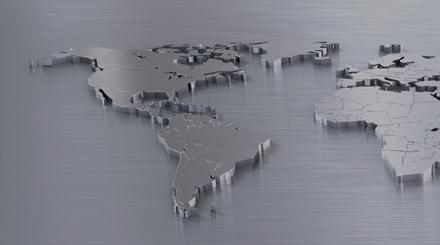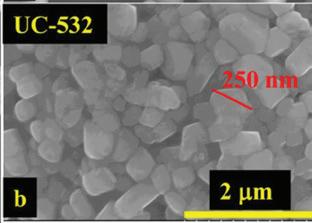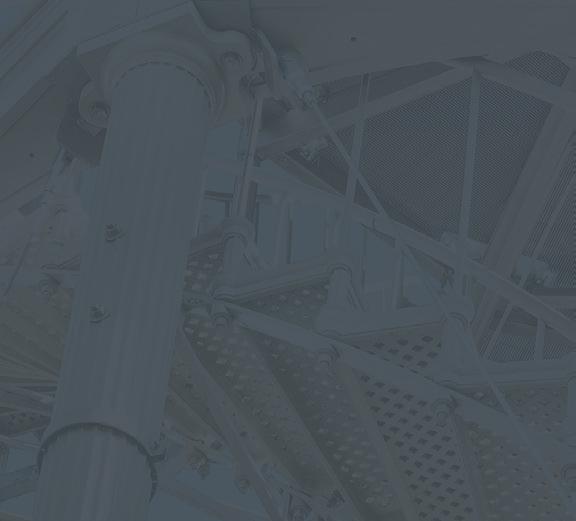In control in subzero temperatures




In control in subzero temperatures



THE MAGAZINE DEVOTED TO NICKEL AND ITS APPLICATIONS
NICKEL, VOL. 35, Nº 3, 2020

nickel extends the range
Innovation driving electric vehicles to greater lengths
Nickel alloys in space resisting heat and cold

Tintagel Bridge was designed by Ney & Partners (Lead Architects and Structural Engineers) and William Matthews Associates (Co-Architects). The steelwork contractor was Underhill Engineering Ltd. and the main contractor American Bridge. The Steel Construction Institute (SCI) and Arup Materials studied the corrosivity of the site and provided advice on material selection.
The ruins around Tintagel Castle in Cornwall, England have long been linked to the legend of King Arthur and the Knights of the Round Table. Some of the ruins are situated on a headland, separated from the mainland by a narrow gorge with steep, rocky cliffs. Until recently, crossing this gorge involved taking a difficult pathway down one cliff in order to reach a short footbridge and then to climb up a similar path on the other side.
A footbridge completed in 2019 now spans the gorge at a higher elevation. This new bridge consists of two cantilever sections which meet high above the gorge.
Because of the narrow lanes leading to the site and the limitations on lifting equipment, a lightweight design in steel was chosen. Six manageable pre-fabricated sections were assembled on site for each cantilever.
In order to provide long-term durability in this marine environment, as well as high strength and a sparkling appearance, important elements of the bridge were fabricated from 20 tons of nickel-containing duplex 2205 stainless steel (UNS S32205). It was used for the diagonals linking
the upper and lower chords, crossbeams, bridge deck bracing and the parapet as well as two 50 mm diameter x 430 mm deck alignment pins, machined connection blocks for the cantilever sections, polished bars (30-65 mm diameter) linking the upper and lower chords of the bridge, trays to hold the slate tiles of the bridge deck and polished components of the balustrade. Additionally, around 2.7 tons of custom-made unequal laser hybrid welded T-sections (272 bars 70 mm high x 60 mm high) were used. This elegant bridge, 66 m long and 2.4 m wide, allows much easier access for the visitors who come each year to discover the legend of King Arthur.

The past year has been one of extremes. Almost all of us have had to rise one way or another to the challenges it has presented. Operating at the extremes, at the farthest point from what we know of as ‘normal’, is now very recognisable to us. And not everything ‘cuts the mustard’ under those conditions!
And so it is in engineering and design. In meeting our goals for the delivery of solutions that satisfy human needs and increasing expectations, in reaching for the extreme and exploring new possibilities, in doing so against the backdrop of higher sustainability, longer life, lower cost –nickel is always there.
In this edition of Nickel we examine some of the demands faced by materials and the answers found in nickel. From standing up to the extremes of temperature in chemical reactions and power generation, to resilience in extreme arctic or marine conditions. Nickel enabling durability and capacity makes extreme cycle life for power cells possible with the prospect of the ‘million-mile’ battery for the next generation of electric vehicles. And even nickel alloys operating at the extremes of our universe. Life on Mars will only be possible with nickel-containing materials to handle the low-temperature conditions on the red planet!
Getting back down to earth, part of the Nickel Institute’s endeavours is to help engineers and materials specialists specify nickel-containing materials with confidence. We are constantly updating our extensive library of freely available technical literature to help achieve this goal. Our latest publication on seawater cooling systems is featured on page 15.
Whatever the great uncertainties are for the coming year, one certainty is that nickel will contribute to overcoming many of our current challenges safely, cleanly and with strength and purpose.
Clare Richardson Editor, NickelThe Princess Elisabeth research station resists the extreme conditions of Antarctica with its façade of nickel-containing 304L stainless steel, chosen for strength and toughness well below -60 °C.





British gong maker Philip James (Turiya sounds) uses nickel silver to create all his instruments. “The sound of a gong is quite unlike anything else,” explains Philip. “it helps one to reach a deeply meditative, transcended state of consciousness”. Nickel silver is an ideal material for fabricating gongs and has unsurpassed sound resonating capabilities. “The fi rst time I heard a gong being played, it took me to such a magical place,” says Philip. “I have been fascinated by them ever since.” UK’s Columbia Metals supplied sheets from 0.8 mm to 1.6 mm thick of NS104 (UNS C75700) which contain 12% nickel and have corrosion and tarnish resistance to levels well above normal brasses. “When it comes to making gongs, there really is nothing quite like nickel silver” says Philip. “It is amazing.”

The distinctive neon blue-green colour sap is a sign of nickel, up to 25%, in rare plants that love high concentrations of metal, with roots that draw it in like a magnet. To date, about 700 hyperaccumulators have been discovered around the world, and field studies have examined their ability to flourish in metal-rich soils. These plants can be phytomined – harvesting the sap and processing it to extract pure nickel or to make nickel chemicals that are suitable for uses like electroplating. While conventional mining operations are far more economically viable to extract metals from high-grade deposits, phytomining’s niche would be low-grade surface deposits found in ultramafic soils in more tropical regions like Cuba, New Caledonia, Australia, and Malaysia. Once phytomined, it has been noted that the soil is substantially more fertile and ready for the production of food crops.

It’s a fresh idea that will turn tons of pineapple waste annually into a multi-purpose, ultra-light, low cost aerogel. Researchers from the National University of Singapore (NUS) have found a method of using pineapple leaf fibres coated with a chemical called diethylenetriamine (DETA), to create eco-aerogels that can remove four times more nickel ions from industrial wastewater compared to conventional methods. Associate Professor Duong Hai-Minh, who leads the team says, “Due to its high porosity, eco-aerogels are highly efficient in removing metal ions, even in dilute solutions where the amount of metal ions is low. The treatment process is simple, cheaper and does not generate secondary waste. Eco-aerogels can also easily desorb the metal ions and be reused several times, further reducing costs. Having developed several other useful applications, this four-year project has resulted in “a big step towards sustainable agriculture and waste management.”

Know the feeling of an ill-fitting COVID-mask steaming up your glasses? Nickel is helping to remedy this while providing invisible comfort. Germany’s cwTec is using a fine nickelcontaining stainless steel strip from Norder Band AG to keep masks fitting snugly on medical professionals and frontline workers who wear glasses and need to see clearly at all times. In addition to its ease of sourcing and the absence of any allergic reactions, the stainless steel strip can be recycled along with the other materials the mask is made of. Quite an achievement for barely one gram of nickelcontaining stainless steel.


Overcoming range anxiety is high on the agenda of electric vehicle manufacturers and battery developers. Professor Jeff Dahn from Dalhousie University and his team in the Department of Physics & Atmospheric Science in Nova Scotia, Canada, have been working on breakthrough single crystal technology that is proving to be a promising solution to this challenge.

“Our goal is to help lower the cost, increase the energy density and improve the lifetime of Li-ion cells,” says Jeff, who has been recognised as one of the pioneering developers of lithium-ion batteries now used worldwide in laptop computers and cell-phones.
Through laboratory testing, they have demonstrated how single crystal technology in Ni-containing cathodes
withstands the microcracking that results with typical electrode materials.
Dahn explains, “Typical cathode particles are generally oriented in sort of random directions. During cycling, when lithium is repeatedly inserted between layers of cathode and then extracted, volume changes. And this change is not the same in all directions. The changes in the direction perpendicular to the layers are large.
When asked about the origin of the ‘million-mile’ battery term, Dahn says, “This just kind of fell out of our work. We published a paper, and one sentence of the abstract said, ‘we show that batteries like this could power electric vehicles for a million miles’. That captured the imagination of the media.”
So, if two primary particles touch, this volume mismatch takes place and that can lead to microcracking of the particle into many small pieces. Consequently, you lose electric contact and start to lose access to cathode’s active mass through that process.”
“A single crystal particle, by contrast, is one crystallite that might be a two to three-micron particle. That’s an entire single crystal where there are no grain boundaries at all, so the whole thing expands and contracts as a unit. That means maintaining an electric connection to these particles as they expand and contract is relatively easy to do. Using a single crystal allows you to maintain a 100% connection to the cathode’s active mass throughout the charge-discharge cycling. It’s quite exciting.”
The team from Dalhousie is working on various single crystal nickelcontaining cathodes which have the advantage of tolerating extensive cycling and at the same time benefit from high energy density. Dahn and his team published a paper in the Journal of The Electrochemical Society, where he concludes “that cells of this type should be able to power an electric vehicle for over

1.6 million kilometres (1 million miles) and last at least two decades in grid energy storage.”
The good news is that this would enable electric car battery packs to last as long as the electric car it powers. Furthermore, switching to single crystal does not add to the cost notably.
“When we make single crystals in our lab, all we are doing is changing a little on the precursor side then heat treating to a slightly higher temperature to grow the single crystals. There is nothing fundamentally different about the whole synthesis process.”
The ultimate prize is the ‘million-mile’ battery.
“It goes to show that there is value in running tests for a very long duration. The cells that are highlighted in this million-mile battery paper, some of them are still on test. I was looking at them the other day. More than three years of running, the room temperature cells are out now to about 9500 cycles (which is well above a million miles of driving) with less than 10 per cent loss, so they are pretty incredible.
(A, a), SEM images of a commercial single crystal Li[Ni0.5Mn0.3 Co 0.2]O2 (NMC532) (called SC-532) material with large grain size of ~3 μm 1.


(B, b)
SEM images of commercial polycrystalline (NMC532) without coating (UC-532) 1.

As it gets colder, even freezing, we tend to lose control over things. Whether it’s people or vehicles, we’ve all been down that slippery slope. But how does nickel enable us to get a grip on technology when the thermometer ominously descends towards the absolute minimum?
Materials for subzero temperatures
Austenitic stainless steels (typically with 7 to 25% Ni) exhibit excellent toughness at very low (cryogenic) temperatures. Toughness is the ability of a material to absorb energy
without breaking, and is essential in many engineering applications. Constructional steels have good toughness at room temperature, but with decreasing temperature, the ferritic structure becomes progressively

more brittle, making such steels unsuitable for service at cryogenic temperatures. In contrast, the common nickel-containing austenitic stainless steels retain good toughness even to liquid helium temperatures.
A second family of materials that exhibits good cryogenic properties is the nickel-alloyed steels. The addition of 1.50 to 9.00% Ni to a steel matrix, together with appropriate heat treatment confers the necessary toughness and strength at temperatures from -60 °C down to -200 °C. Without chromium in the mix however, these steels are not inherently corrosion resistant, like stainless steels.
Arctic areas can be tricky places to recruit staff, weld metal and transport goods to and from. The most critical factor with regard to steels in arctic service is temperature. Temperatures of -50 °C or lower are no exception and are below the ductileto-brittle transition temperature for most carbon-manganese structural steels used for construction in the Arctic oil fields.
Other factors determining material selection for arctic service in the oil and gas industry are corrosion resistance and weldability. The former is not as important for structural applications as for the
production and transportation of corrosive oil and gas. It is important for the welds to retain the enhanced fracture toughness of the base metal used for arctic service. If the weld has inferior toughness, fracture will occur regardless of the quality of the base metal.
Another example comes from scientific infrastructure on Antarctica, where a Belgian research station was erected in 2008. The façade is made of 1.50 mm 304L (UNS S30403) stainless steel panels. This material was chosen because austenic stainless steel (304L) continues to exhibit sufficient strength and toughness well below even -60 °C.
LNG
As energy demand constantly grows and energy transportation and storage become more and more crucial, liquefied natural gas (LNG) looks attractive, because of its ratio of volume to energetic density. The volume of natural gas in its liquid state is about 600 times smaller than its volume in its gaseous state in a natural gas pipeline. The liquefaction process makes it possible to transport natural gas to places where there are no natural gas pipelines and to even use natural gas as a transportation fuel. None of this would be possible without nickel, since natural gas only
Princess Elisabeth Station, Antarctica. The façade is made of 1.50 mm 304L (S30403) stainless steel panels.
Temperature and corrosion resistance as well as weldability are determining factors for material selection for arctic service in the oil and gas industry.

Cross-section of ITER, the International Thermonuclear Experimental Reactor based in France, equipped with a liquid helium cooling system that provides cooling to 4.5 Kelvin.

becomes liquid below -163 °C. As previously described, austentic stainless steel and nickel alloyed steels are the best solutions for assembling storage and transportation vessels and for handling liquefied natural gas at such low temperatures.
Tanker design
LNG tankers predominantly sail from Qatar and Australia to areas with high energy demand such as Japan, China and South Korea. Modern tanker designs make optimum use of hull space by containing the liquefied gas in a double metallic membrane, backed by insulation. Waffled (to allow for expansion and contraction) thin gauge 304L stainless steel or thinner and flat Alloy 36 (K93600), a low thermal expansion 36% Ni alloy, are exclusively used for these cargo containment systems. More liquefied gases
Sliding further down the temperature scale from LNG at -163 °C are:
• -183 °C: liquid oxygen
• -196 °C: liquid nitrogen
• -253 °C: liquid hydrogen
• -269 °C: liquid helium
Applications are often found in industry, which relies on these products in regasified form. Hydrogen is already frequently used as an industrial precursor to ammonia in the fertiliser industry. It also holds a lot of potential to decarbonise the energy mix. Provided that sufficient hydrogen can be produced (preferably green hydrogen from wind or solar power), burning it as a fuel produces just water and no carbon dioxide. The steel industry being energy intensive, several producers are already looking at reducing their carbon footprint by increased use of hydrogen.
There would be no space exploration without liquid gases. Hydrogen is a light and very powerful rocket fuel. Combined with an oxidiser such as liquid oxygen, liquid hydrogen proves the most efficient of all rocket propellants.
Finally, what could possibly cool a superconducting magnet to sustain a plasma state? The answer is simple: liquid helium. But the temperature isn’t. At -269°C or 4 Kelvin, this is where nickel unlocks its full potential...
Reformer tubes are produced from cast nickel alloys, and are used for hundreds of thousands of hours at 800-1000 °C in a carburising environment. They are used with steam and hydrocarbons to produce hydrogen.
Most chemical processes react faster, and power generation operates more efficiently when they run hotter. But will the materials stand up? In practice, the maximum temperature for many processes is limited by material suitability. Nickel can come to the rescue.
The four most important properties when selecting a material for a high temperature application are strength, stability over time, limited reaction with the environment and ease of fabricating the equipment.
As temperature increases, metals become weaker. There are many steels stronger than the 300 series stainless steels at moderately elevated temperatures. At 540 °C stainless steels outperform most of them. And above 650 °C, the nickel-containing alloys excel. But above 540 °C, the creep strength or creep rupture strength become the most important properties.
At high temperature, metallurgical changes can occur with time. The most concerning is when the metal forms hard brittle phases, which can make the material as fragile as glass.
Nickel slows the rate of formation of those phases, with Ni-Cr-Fe alloys containing at least 33% nickel being immune.
At very high temperatures, the metal can react with its environment. In air, it will oxidise. Alloying with chromium and aluminium provides additional protection. In reducing environments with carbon monoxide for example, it is nickel and silicon that help reduce carburisation. In the most severe environments, when rapid carburising (called metal dusting) can occur, new alloys are being developed and tested, all of which are high in nickel. Finally, equipment needs to be fabricated, which involves metal forming and welding, in which the nickel-containing stainless steels and nickel alloys excel.
Radiant tubes indirectly heat furnaces. Various nickel alloys are used, with temperatures as high 1150 °C, even if the metal can tolerate 1200 °C.

Heat treatment baskets hold parts while in heat treatment furnaces. The nickel-containing alloy selected will depend on whether the atmosphere is oxidising or reducing. They typically see rugged service.




2020 marked the start of an exciting new decade in space exploration and innovation with nickel-containing alloys playing an important role in the construction of rockets, wheels, and catalysts, to name a few applications. SpaceX, the American company committed to aerospace manufacture and reusable space transportation, fabricated its Starship and Super Heavy rockets from a version of nickelcontaining 304 (S30400) stainless steel. SpaceX selected stainless steel for the job because it is inexpensive compared to carbon fibre which costs over sixty times more per kilogram. It is also much more resistant to heat than carbon fibre or other metals such as aluminium and thus requires much less, or possibly no, additional heat shielding.
Meanwhile, NASA is exploring another potential application for nickel-containing materials in the wheels of its Rovers. Rubber wheels are impractical on the Moon or Mars, so the wheels on the original Apollo Lunar Rovers were constructed from spring steel. However, spring steel wheels will deform on the larger and heavier vehicles that are designed to be used on Mars. To combat this, NASA is currently developing a metal mesh tire constructed from Nitinol (UNS N01555), a nickel-titanium alloy, NASA engineers attach the latest version of the SMA spring tire to a test rig. This version weighs 7 kg (15 lbs), can carry double the amount of load as the previous version and performs better in the deep space temperatures.


with shape memory properties which can handle 30 times the deformation of the spring steel wheels.

With the goal to eventually transport humans to Mars, the SpaceX Starship with a Raptor rocket engine is one of the first to be powered by liquid methane and liquid oxygen and designed to be reused 1,000 times. Methane was selected because of the intent to produce rocket fuel on Mars to fuel the return trip. Methane can be produced from carbon dioxide and hydrogen through the Sabatier reaction, where hydrogen reacts with carbon dioxide at elevated temperatures (optimally 300–400 ºC) and high pressure with a catalyst, to produce methane and water. One of the possible catalysts is nickel.
While the Martian atmosphere is composed of 95% carbon dioxide, NASA has confirmed the presence of water on Mars, the raw materials necessary to produce methane and oxygen as a rocket propellant as well as breathable oxygen for the astronauts. And the low ambient temperature on the red planet, plus the low temperatures required for handling liquefied methane, hydrogen and oxygen will also require nickel-containing materials.
Ni-Cu Alloy K-500 (N05500) also possesses excellent ductility at cryogenic temperatures and resistance to ignition in pure oxygen. This makes it a preferred choice in oxygen boost pumps supplying oxygen to the rocket engine.
With its high strength and toughness, Alloy 718 (N07718), a precipitationhardenable nickel-chromium alloy used in aircraft turbojet engines, is also used in rocket engines and pressure vessels so they can handle cryogenic liquefied gases for propulsion down to -250 °C. However,
Alloy 718’s properties make machining and forming more difficult than other materials. Investment casting can be problematic as Alloy 718 is susceptible to porosity, segregation and very coarse grain sizes, which calls for subsequent processing steps. The solution? 3D printing allows for more efficient utilisation of nickelbase alloys, such as Alloy 718, in high-performance applications with complicated designs.
3D printing can make Alloy 718 processing more convenient, straight forward and ensure material proper ties are well preserved. This process avoids welding and machining and thus minimises material waste. The benefit of this manufacturing method is demonstrated by the 3D printed Alloy 718 rocket engine prototype, which was entirely designed by artificial intelligence – and developed by German software company Hyperganic.
Unlike a traditional rocket engine, which consists of individually designed parts that are joined together, the 3D printed prototype is one continuous piece. It includes the combustion chamber where fuel and oxidiser are burned, as well as the surface channels through which the fuel is circulated to cool the chamber and keep it from overheating. The one-piece fabrication results in the lowest weight and most effective cooling, providing the highest possible performance for a given rocket.
3D printing has also been used by the University of California at San Diego in the Ignus II Alloy 718 rocket engine for their Vulcan II rocket project.
With each new application, nickel is helping space exploration go further in the future.
super alloys. A high-strength, corrosion-resistant nickelchromium alloy used in the temperature range of -252 ° to 700 °C (-423 ° to 1300 °F). Its strength and resistance to oxidation at high temperatures make it a top choice for rocket engines. And its ductility at cryogenic temperatures enables its selection for tanks holding liquefied rocket fuel.
QQ: I have a nickel allergy and am wondering about the availability of a hypodermic needle that is nickel free?
AA: Nickel in stainless steels, such as Type 304 (S30400), is an essential ingredient, that provides the high ductility, formability and weldability that enables the production of hypodermic needles.
sweat while Type 304 is very corrosion resistant to sweat and releases very little nickel and a hypodermic needle is only in contact with skin for a few seconds.
Geir Moe P.Eng. is the Technical Inquiry Service Coordinator at the Nickel Institute. Along with other material specialists situated around the world, Geir helps end-users and specifiers of nickelcontaining materials seeking technical support. The team is on hand to provide technical advice free of charge on a wide range of applications such as stainless steel, nickel alloys and nickel plating to enable nickel to be used with confidence.

https://inquiries.nickelinstitute.org/
For example, hypodermic needles might start as a flat strip 18 mm wide by 0.5 mm thick wrapped on a large spool. The strip is forced through a set of rolls to be formed into a tube, about 6 mm in diameter, seam welding the two edges. As the welded tube moves down the line it passes through a series of progressively smaller holes known as dies. As the diameter is reduced the strength of the tube increases and must be periodically softened by heating. What started out as 6 mm diameter would be reduced to 0.35 mm diameter, a 95% reduction.
As the outside diameter decreases, the wall thickness also decreases. After the final drawing step, the cold worked material is left in a strong and hard condition.
Most allergic reactions to nickel are from inexpensive nickel-plated jewelry that are in prolonged contact with the skin. Nickel plating can release nickel from contact with
The following link discusses nickel allergy in more detail: nickelinstitute.org/science/humanhealth-fact-sheets/fact-sheet-1-nickelallergic-contact-dermatitis/
Steve Barnett led the Nickel Institute as President during challenging times (2006–2010). His distinguished career in the metals sector spanned forty years. After achieving an MSc in Metallurgy from Imperial College in 1976 and stints at Davy Process Technology and Rustenburg Platinum, he joined what became BHP Billiton, in 1981. There he commissioned the Cerro Matoso ferro-nickel plant in Colombia and worked on base metals projects. He spent time in mergers

and acquisitions in The Hague and Johannesburg. In 1996 he moved to Brisbane to lead project development and HSEC for Billiton Nickel, and then BHP Billiton Stainless Steel Materials, before joining the Nickel Institute. Steve was truly international, talented, charismatic, optimistic, able and courageous, and remained so until his untimely passing on 4 November 2020 in Brisbane. He will be deeply missed by friends and colleagues in the nickel industry.
Copper alloys versus stainless steels for seawater cooling systems – the pros and cons (11027) compares the use of copper alloys such as 70/30 and 90/10 copper-nickel and nickel-aluminium bronze to the use of both austenitic





and duplex stainless steels. The brand new publication, written by Nickel Institute consultant Roger Francis, will assist designers and plant operators to select the proper alloy. Available to download free from www.nickelinstitute.org






New York City’s Harlem Fire Watchtower which dates from 1856, is one of America’s oldest surviving cast iron framed structures and listed on the National Register of Historic Places. The structure had fallen into disrepair and was near collapse due to corrosion and structural movement.

Thornton Tomasetti’s multidisciplinary restoration and renewal team was retained to oversee the restoration. Their modeling of the tower revealed that the original structural design was inadequate. When the restored tower elements were carefully reassembled, an elaborate stainless steel bracing system was added to address this structural deficiency and meet the preservation goals.
Highly corrosion resistant and high strength, cold worked Type 316L (UNS S31603) stainless steel was specified for
the tie rod cross bracing. The material’s high strength allowed the diameter of the rods to be reduced. A softly reflective bead blasted finish was applied to the stainless steel to scatter the light and make it less visible. The stainless steel is visually distinct from the historic iron and minimally visible, as is required in historic preservation. The restoration project received the 2020 Lucy G. Moses Award for outstanding preservation and the Municipal Arts Society MASterworks Award for Best Restoration in New York City.